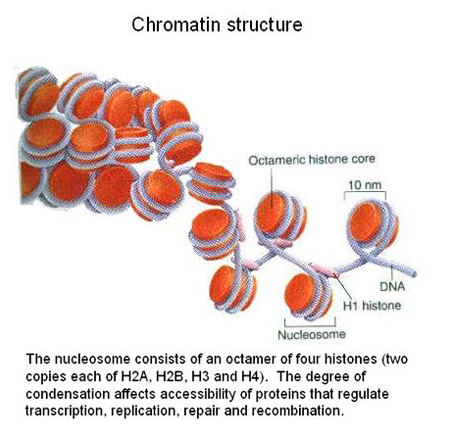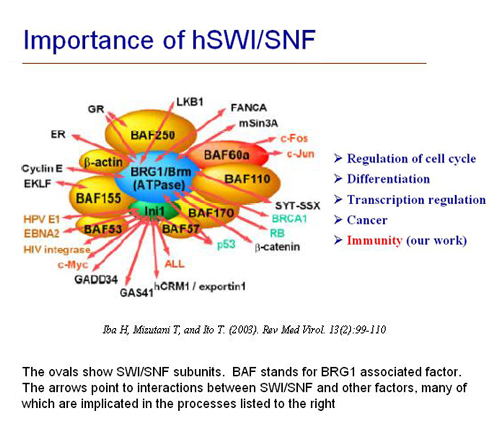| |
Chromatin Remodeling in Cancer and Immunity
 DNA is wound around nucleosomes that each consist of an octamer of histone proteins. The DNA/nucleosome complex is termed chromatin. The least condensed form of chromatin is the classic "beads on a string", which is 10nm in diameter. This structure can coil into more condensed forms. Chromatin is far more than a packing material. It plays a dynamic role in controlling every process associated with genome regulation (transcription, replication, repair, recombination). Defects in enzymes that regulate chromatin accessibilty cause numerous diseases, including cancer. These enzymes come in two flavours: one set that covalently modify histones and another that uses the energy from ATP to remodel chromatin. We showed (Pattenden et al 2002) PDF that the grandfather of all chromatin remodeling complexes, SWI/SNF (pronounced `switch-sniff`) is required for the induction of a gene called CIITA by interferon-g (IFNg) DNA is wound around nucleosomes that each consist of an octamer of histone proteins. The DNA/nucleosome complex is termed chromatin. The least condensed form of chromatin is the classic "beads on a string", which is 10nm in diameter. This structure can coil into more condensed forms. Chromatin is far more than a packing material. It plays a dynamic role in controlling every process associated with genome regulation (transcription, replication, repair, recombination). Defects in enzymes that regulate chromatin accessibilty cause numerous diseases, including cancer. These enzymes come in two flavours: one set that covalently modify histones and another that uses the energy from ATP to remodel chromatin. We showed (Pattenden et al 2002) PDF that the grandfather of all chromatin remodeling complexes, SWI/SNF (pronounced `switch-sniff`) is required for the induction of a gene called CIITA by interferon-g (IFNg)
CIITA stands for Class II TransActivator and is the master regulator of MHC class II expression. Children lacking CIITA die at a young age from infections. The IFNg pathway is also important in the process known as immune surveillance, a defense system that can recognize and clear emerging tumors. Mice lacking the IFNg receptor, or STAT1, the transcription factor that is activated by IFNg signaling, are more tumour prone. Thus, one way tumors might escape immune surveillance is to perturb SWI/SNF function and, therefore, IFNg signaling. Indeed, defects in SWI/SNF subunits have been found in a variety of cancers.
 We are elucidating the mechanism by which SWI/SNF regulates CIITA induction. We use chromatin immunoprecipitation (ChIP) to study the recruitment of SWI/SNF and other factors to the CIITA locus in vivo. We used this approach to show that BRG1, a critical SWI/SNF subunit, is inducibly recruited to the CIITA IFNg-responsive promoter (Pattenden et al 2002) PDF and to elucidate the mechanism by which cytomegalovirus (CMV) interferes with IFNg signaling (Popkin et al, 2003). PDF We are elucidating the mechanism by which SWI/SNF regulates CIITA induction. We use chromatin immunoprecipitation (ChIP) to study the recruitment of SWI/SNF and other factors to the CIITA locus in vivo. We used this approach to show that BRG1, a critical SWI/SNF subunit, is inducibly recruited to the CIITA IFNg-responsive promoter (Pattenden et al 2002) PDF and to elucidate the mechanism by which cytomegalovirus (CMV) interferes with IFNg signaling (Popkin et al, 2003). PDF
At the CIITA locus, we have determined the order of recruitment relative to other transcription factors and chromatin changes that activate this gene, and the steps that require SWI/SNF (Ni et al, in preparation).
|
|


 DNA is wound around nucleosomes that each consist of an octamer of histone proteins. The DNA/nucleosome complex is termed chromatin. The least condensed form of chromatin is the classic "beads on a string", which is 10nm in diameter. This structure can coil into more condensed forms. Chromatin is far more than a packing material. It plays a dynamic role in controlling every process associated with genome regulation (transcription, replication, repair, recombination). Defects in enzymes that regulate chromatin accessibilty cause numerous diseases, including cancer. These enzymes come in two flavours: one set that covalently modify histones and another that uses the energy from ATP to remodel chromatin. We showed (
DNA is wound around nucleosomes that each consist of an octamer of histone proteins. The DNA/nucleosome complex is termed chromatin. The least condensed form of chromatin is the classic "beads on a string", which is 10nm in diameter. This structure can coil into more condensed forms. Chromatin is far more than a packing material. It plays a dynamic role in controlling every process associated with genome regulation (transcription, replication, repair, recombination). Defects in enzymes that regulate chromatin accessibilty cause numerous diseases, including cancer. These enzymes come in two flavours: one set that covalently modify histones and another that uses the energy from ATP to remodel chromatin. We showed ( We are elucidating the mechanism by which SWI/SNF regulates CIITA induction. We use chromatin
We are elucidating the mechanism by which SWI/SNF regulates CIITA induction. We use chromatin 


